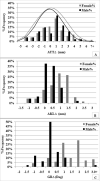Knee joint laxity and its cyclic variation influence tibiofemoral motion during weight acceptance
- PMID: 20581718
- PMCID: PMC2992800
- DOI: 10.1249/MSS.0b013e3181ed118d
Knee joint laxity and its cyclic variation influence tibiofemoral motion during weight acceptance
Abstract
Purpose: to better understand how sex differences in anterior knee laxity (AKL) affect knee joint biomechanics, we examined the consequence of greater absolute baseline (males and females) and cyclic increases in AKL during the menstrual cycle (females) on anterior tibial translation (ATT) as the knee transitioned from non-weight-bearing to weight-bearing conditions, while also controlling for genu recurvatum (GR).
Methods: males and females (71 females and 48 males, aged 18-30 yr) were measured for AKL and GR and underwent measurement of ATT. Women were tested on the days of their cycle when AKL was at its minimum (T1) and maximum (T2); males were matched in time to a female with similar AKL. Linear regressions examined relationships between absolute baseline (AKLT1, GRT1) and cyclic changes (Δ = T2 - T1; AKLΔ, GRΔ) (females only) in knee laxity with ATT as measured at T1 and T2 and Δ (T2 - T1) (females only).
Results: AKL and GR increased in females, but not in males, from T1 to T2. Greater AKLT1 and GRT1 predicted greater ATTT1 and ATTT2 in males (R = 21.0, P < 0.007). The combination of greater AKLT1, AKLΔ, and less GRΔ predicted greater ATTT1 and ATTT2 in females (R = 12.5-13.1, P < 0.05), with AKLΔ being a stronger predictor (coefficient, P value) of ATTT2 (0.864, P = 0.027) compared with ATTT1 (0.333, P = 0.370). AKLΔ was the sole predictor of ATTΔ (R = 0.104 and 0.740, P = 0.042).
Conclusions: greater absolute baseline and cyclic increases in AKL were consistently associated with greater ATT produced by transition of the knee from non-weight-bearing to weight-bearing. Because the anterior cruciate ligament is the primary restraint to ATT, these findings provide insight into the possible mechanisms by which greater AKL may be associated with at-risk knee biomechanics during the weight acceptance phase of dynamic tasks.
Figures


Similar articles
-
Cyclic variations in multiplanar knee laxity influence landing biomechanics.Med Sci Sports Exerc. 2012 May;44(5):900-9. doi: 10.1249/MSS.0b013e31823bfb25. Med Sci Sports Exerc. 2012. PMID: 22033513 Free PMC article.
-
Nonweight-bearing anterior knee laxity is related to anterior tibial translation during transition from nonweight bearing to weight bearing.J Orthop Res. 2006 Mar;24(3):516-23. doi: 10.1002/jor.20040. J Orthop Res. 2006. PMID: 16456828
-
Variations in varus/valgus and internal/external rotational knee laxity and stiffness across the menstrual cycle.J Orthop Res. 2011 Mar;29(3):318-25. doi: 10.1002/jor.21243. Epub 2010 Sep 29. J Orthop Res. 2011. PMID: 20882589 Free PMC article.
-
A comparison of cyclic variations in anterior knee laxity, genu recurvatum, and general joint laxity across the menstrual cycle.J Orthop Res. 2010 Nov;28(11):1411-7. doi: 10.1002/jor.21145. J Orthop Res. 2010. PMID: 20872575 Free PMC article.
-
Objective measurement devices to assess static rotational knee laxity: focus on the Rotameter.Knee Surg Sports Traumatol Arthrosc. 2012 Apr;20(4):639-44. doi: 10.1007/s00167-011-1876-3. Epub 2012 Jan 14. Knee Surg Sports Traumatol Arthrosc. 2012. PMID: 22246547 Review.
Cited by
-
Effects of the menstrual cycle on lower-limb biomechanics, neuromuscular control, and anterior cruciate ligament injury risk: a systematic review.Muscles Ligaments Tendons J. 2017 May 10;7(1):136-146. doi: 10.11138/mltj/2017.7.1.136. eCollection 2017 Jan-Mar. Muscles Ligaments Tendons J. 2017. PMID: 28717621 Free PMC article. Review.
-
Accuracy of calendar-based methods for assigning menstrual cycle phase in women.Sports Health. 2013 Mar;5(2):143-9. doi: 10.1177/1941738112469930. Sports Health. 2013. PMID: 24427382 Free PMC article.
-
ACL Research Retreat VI: an update on ACL injury risk and prevention.J Athl Train. 2012 Sep-Oct;47(5):591-603. doi: 10.4085/1062-6050-47.5.13. J Athl Train. 2012. PMID: 23068597 Free PMC article. No abstract available.
-
Cyclic variations in multiplanar knee laxity influence landing biomechanics.Med Sci Sports Exerc. 2012 May;44(5):900-9. doi: 10.1249/MSS.0b013e31823bfb25. Med Sci Sports Exerc. 2012. PMID: 22033513 Free PMC article.
-
ACL Research Retreat VII: An Update on Anterior Cruciate Ligament Injury Risk Factor Identification, Screening, and Prevention.J Athl Train. 2015 Oct;50(10):1076-93. doi: 10.4085/1062-6050-50.10.06. Epub 2015 Sep 4. J Athl Train. 2015. PMID: 26340613 Free PMC article. No abstract available.
References
-
- Beynnon BD, Fleming BC, Labovitch R, et al. Chronic anterior cruciate ligament deficiency is associated with increased anterior translation of the tibia during the transition from non-weightbearing to weightbearing. J Orthop Res. 2002;20:332–337. - PubMed
-
- Butler DL, Noyes FR, Grood ES. Ligamentous restraints to anterior-posterior drawer in the human knee. J Bone Joint Surg. 1980;62-A(2):259–270. - PubMed
-
- Chandrashekar N, Mansour JM, Slauterbeck J, et al. Sex-based differences in the tensile proerties of the human anterior cruciate ligament. J Biomech. 2006;39:2943–2950. - PubMed
-
- Chandrashekar N, Slauterbeck J, Hashemi J. Sex-Based Differences in the Anthropometric Characteristics of the Anterior Cruciate Ligament and Its Relation to Intercondylar Notch Geometry. Am J Sports Med. 2005;33(10):1492–1498. - PubMed
-
- Dejour D, Bonin N, Locatelli E. Tibial antirecurvatum osteotomies. Oper Tech Sports Med. 2000;8(1):67–70.
Publication types
MeSH terms
Grants and funding
LinkOut - more resources
Full Text Sources

